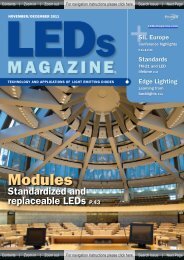LEDs Magazine Review - Beriled
LEDs Magazine Review - Beriled
LEDs Magazine Review - Beriled
- No tags were found...
You also want an ePaper? Increase the reach of your titles
YUMPU automatically turns print PDFs into web optimized ePapers that Google loves.
LEDSMAGAZINE4.35%air67.8%GaN23.5%substrate4.35%airFig. 2. Light emission from the active layer in an LED is hindered bythe high refractive index step between the semiconductor layer andair. Figures show the percentage of light in each layer.features are all factors that influence the specific optical properties ofthe structure. Further fine-tuning can be accomplished by filling thestructure with a material of differing refractive index.In simple terms, planar PCs represent a range of tools that can beused to control the emission and propagation of light on a scale smallenough to permit their use in integrated optical systems. More specifically,this includes short-range spatial beam steering, spectral filtering,polarization control, optical time delay and beam division. Forexample, a planar PC structure introduced into the output facet of aVCSEL provides increased lateral control of the lasing mode profile,enabling these top-emitting laser diodes to be driven at higher outputpowers without sacrificing the coupling efficiency into singlemodetelecommunications fibers (see, for example, www.alight.dk).LED manufacturingThe increased interest in the use of planar PC structures for more complexoptical tasks is due to the recently acquired ability to create intricate2D structures using nanoimprint lithographic techniques. In theinstance of LED manufacturing, the PC is imprinted into the topmostsurface of the LED, namely into the semiconductor material coveringthe active layer.Critically, nanoimprinting lends itself to the cost-effective manufactureof custom photonic crystal patterns in large volume and is thusan important enabler for the LED industry. As we shall see, it is theability to reliably produce structures with seemingly peculiar symmetriesthat allows the realization of LED devices with both enhancedlight output and tailored illumination profiles.Fig. 3. SEM images of fabricated pinwheel (a) and sunflower (b)photonic quasicrystals.Emission enhancement with photonic crystalsThe problem with <strong>LEDs</strong> is the high refractive index of the semiconductormaterial sandwiching the active quantum well layers. As thesemiconductor interfaces directly to air at the output facet, a significantamount of the light generated inside the active region remainstrapped within the capping layer (see figure 2).Extraction efficiency can be improved by something as simple asroughening the emitting surface, or by adding features like microlensesto the surface of the LED to help channel the emission. However, earlyPC-patterned LED structures have already been shown to increase thelight extraction efficiency several-fold and now newer, optimizeddesigns are responsible for generating still higher extraction efficiencies.The PC structure improves emission extraction by providingpreferred leakage paths out of the LED structure for photonstrapped in the capping layer.Emission management with photonic quasicrystalsIn spite of the gain in extraction efficiency, the problem with regularPC structures is that they are anisotropic, i.e. the regularity of the structuretranslates into a gain in the light extraction that is directionallydependent. More exactly, there is an interplay between the gain inoverall extraction efficiency, its variation into different emission directionsand the overall illumination homogeneity of the emission cone.This interplay is decided by the design parameters chosen for the PC,with the result that not all of these aspects can be optimized independentlyof one another. For example, while the overall intensity canincrease compared with a Lambertian emitter, this can be at the expenseof the spatial distribution of the light flux.The most common PC geometries are based on naturally occurringsymmetries, like square or triangular, but similar structures can be22© Copyright 2006 IOP Publishing Ltd www.iop.org and Cabot Media Ltd. All rights reservedledsmagazine.com August 2006
















